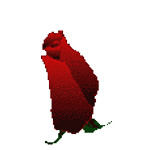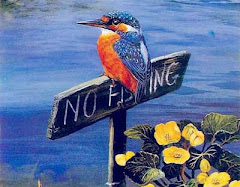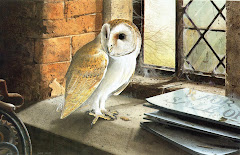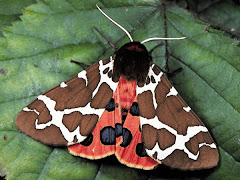18.3.10
~Spring arose…

English: Anglo-Nubian goat, Nubian goat ·
Nederlands: Nubische geit, Anglo-Nubische geit ·
And Spring arose on the garden fair,
Like the Spirit of Love felt everywhere;
And each flower and herb on Earth's dark
breast rose from the dreams of its' wintery rest.
~ by Percy Bysshe Shelley
10.3.10
~Tot Ziens

Ik hou even op met bloggen
We gaan verhuizen en heb heel veel om in te pakken
en voorlopig dus géén tijd om te bloggen.
Zodoende zeg ik jullie vanaf hier “Tot Ziens”
Ik zie jullie later wel weer!!!
.
I have to end this blog for now
We are gonna move, and very little time for
fun things like blogging!
So I have to say goodbye for now!
See you in a short while Again!!!
Illustration by Danielle Barlow
9.3.10
~Thornbirds
De Doornvogel is een geslacht uit de Ovenvogels.
Ze zijn een familie
van vogels uit de orde zangvogels.
De familie telt 305 soorten.
Ze danken de naam aan de vorm van het nest
dat lijkt op een oven.
~ LINK ~

The thornbirds are related to ovenbirds such
as the Rufous Hornero.
There are three geographically separated
races of this species.
This is the nominate sub-species which
has a rufous forehead.
The most noticeable feature of these rather
drab birds are the enormous stick nests which they build.
These can be up to 2 metres long. The scale can be judged
in the photo from the thornbird sitting
on the top of the nest.

These nest have several chambers although
only one is used. This elaborate set-up is
presumably a defence against predators.

You are likely to see several nests in the same
tree but this does not signify that there it nests
in colonies. In fact, the same pair will build a new
nest each year and usually in the same or a nearby tree.
As a general rule, the higher the nest the more
recent it will be.
~ LINK ~
Species:
-Phacellodomus rufifrons (Rufous-fronted Thornbird)
-Phacellodomus inornatus (Plain Thornbird)
-Phacellodomus sibilatrix (Little Thornbird)
-Phacellodomus striaticeps (Streak-fronted Thornbird)
-Phacellodomus striaticollis (Freckle-breasted Thornbird
-Phacellodomus maculipectus (Spot-breasted Thornbird
-Phacellodomus dorsalis (Chestnut-backed Thornbird)
-Phacellodomus ruber (Greater Thornbird)
-Phacellodomus erythrophthalmus (Orange-eyed Thornbird)
-Phacellodomus ferrugineigula (Red-eyed Thornbird)
There is a legend
about a bird that sings
once in its life, more
sweetly than any other creature
on the face of the earth.
From the moment it leaves the nest,
it searches for a thorn tree, and
does not rest until it has found one.............
For the best is only bought
at the cost of great pain....
or so says the legend.
by Colleen McCullough
~Shetland Schaap

Dit kleine tengere schaapje is afkomstig van de
Shetland Eilanden. Daar zijn ruim 1000 jaar geleden
schapen door de Vikingen gebracht.
Deze zijn waarschijnlijk gekruist met schapen die al
op de eilanden waren. Door de geïsoleerde ligging
zijn de specifieke raskenmerken goed bewaard gebleven.
Het eerste onderzoek naar het Shetland-schaap
dateert uit 1790. Later volgden meer onderzoeken
en allemaal roemden ze de fijne, zachte wol.
In het begin van de twintigste eeuw werd het schaap
gekruist met andere rassen. Dat kwam de wolkwaliteit
echter niet ten goede. Men is zich toen gaan toeleggen
op het fokken van raszuivere schapen.

Raskenmerken:
Shetlandschapen zijn kleine, tengere dieren.
Ze zijn aangepast aan het leven in vrij barre omstandigheden
in een heuvelachtig landschap. Rammen hebben horens:
die zijn in ronde secties verdeeld en draaien in een
spiraal langs het hoofd vanuit een wijd uitstaande
basis. Ooien hebben geen horens. De spiraalvorm
neemt met de jaren toe. Neus en voorhoofd zijn
duidelijk apart te onderscheiden. De oren zijn klein
en staan vrij achteraan op het hoofd.
De poten zijn vrij dun en gemiddeld van lengte.
De staart is karakteristiek van vorm en lijkt op een
ankerblad: breed aan de basis, dan langzaam dunner
wordend en bij het eind smal uitlopend op een punt.

Verdere eigenschappen:
De schapen zijn bijzonder taai en kunnen met
weinig voedsel overleven. Ze zijn vruchtbaar,
lammeren vrij makkelijk af en leven lang.
Men kan drie Shetlanders houden in plaats van
twee schapen van een ander ras. Ze zijn lenig en
klauteren graag. Water kunnen ze als een hond van
zich afschudden. Hiermee voorkomen ze dat hun
vacht vervilt. Afhankelijk van het gebied en de
omstandigheden waar ze leven, weegt een
volwassen ooi ongeveer 35 tot 40 kg.
Een ram is wat zwaarder. Het vlees is kruidig,
van uitstekende kwaliteit en niet vet.
Verder zijn ze niet bijzonder gevoelig voor ziekten.
~ MEER INFO HIER EN HIER ~

Wol:
Het belangrijkste kenmerk van het Shetland-schaap
is de goede kwaliteit wol die zij levert.Ook komen
veel kleurvariaties voor: wit, veenbruin(moorit),
grijstinten, reebruin(fawn), donkerbruin en zwart.
De zwarte schapen komen niet veel meer voor.
Veel lammetjes die zwart geboren worden,
verkleuren later naar bijvoorbeeld grijs.
In de maanden mei, juni, juli gaat de vacht los
zitten en valt uit. Tenminste als die niet geschoren
of met de hand geplukt wordt.
De wol is goed te spinnen en verder te verwerken.
Vilten kan ook heel goed.
There have been sheep on the Shetland Isles
for a very long time. They have changed in response
to additions to the gene pool and the selection pressures
of their environment and their shepherds.
The classic Shetland probably dates from the 1700s.
Classified as a primitive breed, Shetlands are small,
fine-boned sheep belonging to the Northern
Short-tailed group. They have adapted to the
topographic and climatic conditions of Shetland for over
a thousand years. They are very hardy and have the
ability to thrive on low levels of nutrition.
They are prolific with a prolificacy of about 160%.
They are highly adaptable and succeed well in less rigorous
conditions off the Shetland Islands. There is a
considerable variation in height and weight of
sheep depending on feeding conditions.
For example hill sheep in Shetland, out-wintered
as lambs, have a live weight of about 22kg whereas
a park-fed ewe in the south of England averages 45kg.
A ram in peak condition could weigh as much as 65kg.
Rams may be horned or polled. Ewes are normally
polled but occasionally may develop short horns
that curve backwards.

7.3.10
6.3.10
~Sunday Poem!
Curly-locks, Curly-locks, wilt thou be mine?
Thou shalt not wash the dishes, nor yet feed the swine;
But sit on a cushion, and sew a fine seam
And feed upon strawberries, sugar, and cream.
Painting by Jessie Wilcox Smith
1.3.10
~Mmmm Jammie!
Dit zijn 2 van de kipjes die wij verzorgen
Het kipje vooraan heet Liesje!
Zij heeft de broodkruimels ontdekt die ik voor
de musjes had achtergelaten…
Sorry musjes, tegen die tijd
dat Liesje hier wegloopt is vast alles opgegeten!
Het zwart witte Wyandotje heet Whitney
en volgt Liesje altijd overal!
en zo dus ook op deze verhoging in de tuin!
Liesje is the name of the chicken in the front
She discovered the breadcrumbs for the sparrows!
The black and white chicken is called Whitney!
She always follows Liesje everywhere
so she discoverd the crumbs too,
but not the other chickens, they mist the whole thing!
De andere kipjes hebben totaal niets in de gaten
en komen niet eens kijken!
Maar Onze Sissy, het zijdehoentje wel…
Ze kan dan wel niet zo hoog springen als de andere kipjes
en kiest ze ervoor om veilig beneden te blijven,
waar Toch ook nog wel wat van die heerlijke
kruimeltjes te vinden zijn!
This is Sissy - she is a Black-Bone Silky Fowl!
She can’t jump as high as the other chickens
so she’ll eat the crumbs which are falling on the ground
They are still very tasty!!!




















































